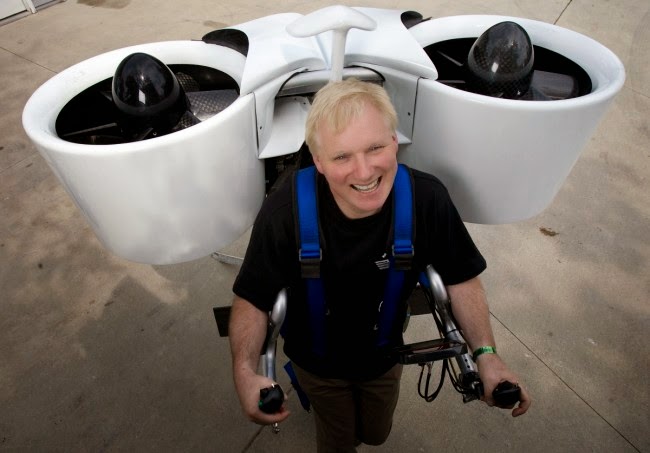Martin Aircraft Company is building a one person jetpack it claims will go on sale in 2016. Today it revealed a new contract will see it developing airborne technology capabilities for the United States Department of Homeland Security, Department of Defense, and other federal, state, and local agencies. The deal, with US company, Avwatch, will see the two companies working together on improving specific capabilities targeted at assisting the first responder sector, including search and rescue, security, police, ambulance, fire and natural disaster recovery. The package will also include a simulator for training and mission rehearsal and the necessary support of all the fetpack flying. The jetpack itself is a carbon-fibre frame housing a two-litre, 200 horsepower petrol engine, which powers two large rotors positioned either side of the standing pilot. It can carry 120 kilograms and fly at up to 74 km/h for 30 minutes at altitudes of 1000 metres.
The pilot navigates via two joysticks positioned next to each hand. New Zealander Glenn Martin first came up with the idea sixteen years ago. 12 prototypes later, his company, Martin Aircraft, is looking to raise $25 million in a November listing on the Australian stock exchange. The first orders are expected to be penned next year, with the first models zooming around the skies within two years. But at an estimated $215,000 pricetag, they won't be for the man in the street. Instead, they're designed for the 'first responder' market: paramedics, firefighters, border patrol.
'We've had paramedics who've come to us and said they work in large cities, and when there's an accident they have trouble getting there because traffic's so bad,' Martin said. 'The advantage of this is that it can land in very small spaces - much smaller than a helicopter can land in - right beside an accident.' 'The company has had a 'deluge' of inquiries from companies, governments, and even the odd millionaire playboy,' Martin said.
He declined to name names, but said 80 per cent of inquiries had come from the United States. In the US, the firm has partnered with Avwatch, founded by former Coast Guard Rescue Pilot, Chris Kluckhuhn in 2008. Kluckhuhn said 'The Martin Jetpack is a disruptive technology, much like the helicopter was when first developed, with substantial capabilities which will be very complementary to our solutions we can offer our customers. It's a carbon-fibre frame housing a two-litre, 200 horsepower petrol engine, which powers two large rotors positioned either side of the standing pilot. It can carry 120 kilograms and fly at up to 74 km/h for 30 minutes at altitudes of 1000 metres. The pilot navigates via two joysticks positioned next to each hand. Mr Martin, who formerly worked in pharmaceuticals, says he dreamed of his own jetpack from an early age.
'I was brought up in the 1960s, saw the space program, always wanted a jetpack, saw jetpacks on The Jetsons, Lost in Space, Thunderbirds. 'But a few years later I found that I was 21, at university, and there were no jetpacks.
HOW IT WORKS
The jetpack is a carbon-fibre frame housing a two-litre, 200 horsepower petrol engine, which powers two large rotors positioned either side of the standing pilot. It can carry 120 kilograms and fly at up to 74 km/h for 30 minutes at altitudes of 1000 metres. The pilot navigates via two joysticks positioned next to each hand.


